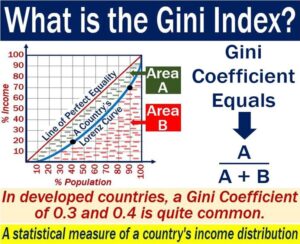
Pic Courtesy: Businessline
Italian statistician Corrado Gini, developed the Gini coefficient in 1912. It ranges from 0 to 1, but is often written as a percentage.
Defnition. The Gini coefficient (also known as Gini index or Gini ratio) is one of the most frequently used statistical measure of economic inequality in a population. The coefficient measures the dispersion of income or distribution of wealth among the members of a population.
Importance. A country’s Gini coefficient is important because it helps identify high levels of income inequality, which can have several undesirable political and economic impacts. These include slower GDP growth, reduced income mobility, greater household debt, political polarization, and higher poverty rates.
Repercussions.
- An increase in the Index implies that the government’s policies benefit the rich more than the poor and are not inclusive enough.
- So, a higher ratio may encourage the government to spend more on social welfare schemes and also increase the tax burden on the rich.
- It is important that the government tries to maintain a good ratio so that the rich-poor divide can be kept in check.

Pic Courtesy: Market business news
